Description
Colored pavement within a bicycle lane increases the visibility of the facility, identifies potential areas of conflict, and reinforces priority to bicyclists in conflict areas and in areas with pressure for illegal parking. Colored pavement can be utilized either as a corridor treatment along the length of a bike lane or cycle track, or as a spot treatment, such as a bike box, conflict area, or intersection crossing marking. Color can be applied along the entire length of bike lane or cycle track to increase the overall visibility of the facility. Consistent application of color across a bikeway corridor is important to promote clear understanding for all users.
Click on the images below to view 3D concepts of colored bicycle lanes. The configurations shown are based on San Francisco, CA, Portland, OR, and New York City examples.
Treatment details can be accessed below under design guidance.
Colored Bike Facility Benefits
- Promotes the multi-modal nature of a corridor.
- Increases the visibility of bicyclists.
- Discourages illegal parking in the bike lane. Read More+
“Anecdotally, most cyclists like the green paint treatment and believe that it is more effective at keeping cars from parking in bike lanes than regular striping. In particular, cyclists cite the conspicuousness of cars parked in green painted lanes as a deterrent to drivers parking there.”
New York City Department of Transportation. (2011). Evaluation of Solid Green Bicycle Lanes, to Increase Compliance and Bicycle Safety.
- When used in conflict areas, raises motorist and bicyclist awareness to potential areas of conflict. Read More+
- Increases bicyclist comfort though clearly delineated space. Read More+
- Increases motorist yielding behavior. Read More+
“Significantly more motorists yielded to bicyclists after the blue pavement had been installed (92 percent in the after period versus 72 percent in the before period.”
Hunter, W.W. et al. (2000). Evaluation of Blue Bike-Lane Treatment in Portland, Oregon. Transportation Research Record, 1705, 107-115.
“A higher percentage of motorists yielded to bicycles in the after period (86.7% before versus 98.5% after). A chi-square test revealed the differences to be statistically significant at the 5% significance level (p < 0.001).”
William W. Hunter, W., Srinivasan, R., Martell, C. (2008). Evaluation of a Green Bike Lane Weaving Area in St. Petersburg, Florida. University of North Carolina Highway Safety Research Center.
“The proportion of yielding events that were resolved by the motorist yielding to the bicyclist increased from 63% to 78% after the colored lane treatment was installed. Additionally, the proportion of motorists who used a turn signal before crossing the conflict zone when a bicyclist was present increased significantly from 38% to 74% after the colored lane treatment.”
Brady, J., Mills, A., Loskorn, J., Duthie, j., Machemehl, R., Center for Transportation Research. (2010). Effects of Colored Lane Markings on Bicyclist and Motorist Behavior at Conflict Areas. City of Austin, Texas.
- Helps reduce bicycle conflicts with turning motorists. Read More+
Typical Applications
- Within bike lanes or cycle tracks.
- Across turning conflict areas such as vehicle right turn lanes.
- Across intersections, particularly through wide or complex intersections where the bicycle path may be unclear. Read More+
“Overall, more cyclists followed the recommended path after the blue marking: 87 percent before versus 94 percent after.”
Birk, M., Burchfield, R., Flecker, J., Hunter, W.W., Harkey, D.L., and Stewart, J.R. (1999). Portland’s Blue Bike Lanes: Improved Safety Through Enhanced Visibility. City of Portland Office of Transportation.
- Across driveways and Stop or Yield-controlled cross-streets.
- Where typical vehicle movements frequently encroach into bicycle space, such as across ramp-style exits and entries where the prevailing speed of turning traffic at the conflict point is low enough that motorist yielding behavior can be expected.
- Color may be applied along an entire corridor, with gaps in coloring to denote crossing areas. Read More+
“NYCDOT data indicates that the green paint treatment resulted in fewer instances of drivers encroaching on the bike lane by driving on the bike lane boundary line. Overall, 7% of drivers on the green paint treated streets drove on the bike lane boundary line as opposed to 16% of drivers on streets with the typical non-painted bike lane treatment. The data also showed fewer instances in driving in the bike lane; on average, 4% of drivers drove in the bike lane on green paint treated streets as opposed to 7% of typical streets.”
New York City Department of Transportation. (2011). Evaluation of Solid Green Bicycle Lanes, to Increase Compliance and Bicycle Safety.
- Facility designers should match coloring strategy to desired design outcomes of projects.
- May not be applicable for crossings in which bicycles are expected to yield right of way, such as when the street with the bicycle route has Stop or Yield control at an intersection.
Design Guidance
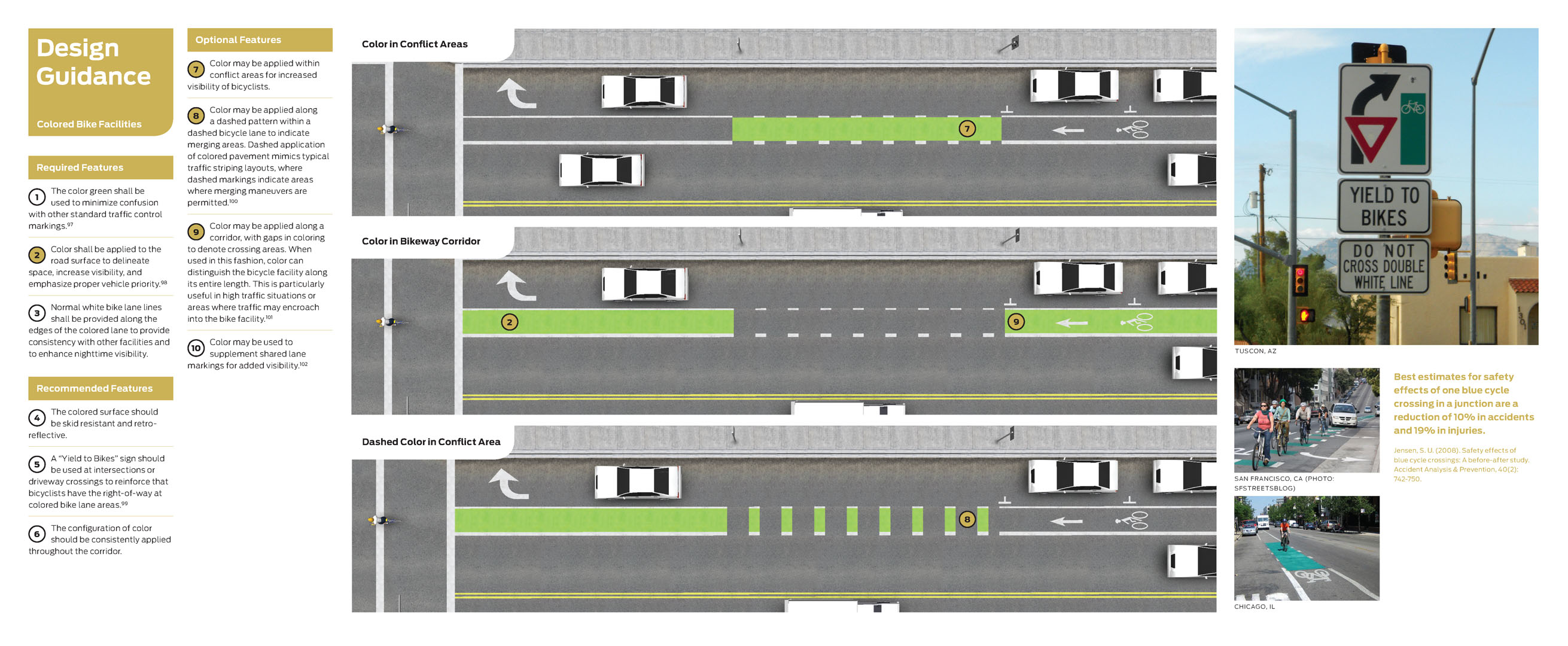
Guidance for conventional bicycle lanes, intersection crossing markings, and through bike lanes may also apply.
| Required Features |
 |
The color green shall be used to minimize confusion with other standard traffic control markings. Read More+
Yellow, white, red, blue, and purple all have defined standard uses in the MUTCD.
Blue is specifically discouraged for use on bicycle lanes to prevent confusion with parking for persons with disabilities.
“When used, blue markings shall supplement white markings for parking spaces for persons with disabilities.”
Federal Highway Administration. (2009). Manual on Uniform Traffic Control Devices. Section 3A.05.
|
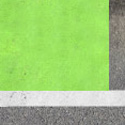 |
Color shall be applied to the road surface to delineate space, increase visibility, and emphasize proper vehicle priority. Read More+
|
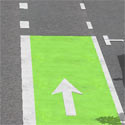 |
Normal white bike lane lines shall be provided along the edges of the colored lane to provide consistency with other facilities and to enhance nighttime visibility. |
| Optional Features |
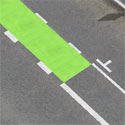 |
Color may be applied within conflict areas for increased visibility of bicyclists. |
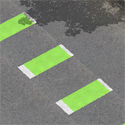 |
Color may be applied along a dashed pattern within a dashed bicycle lane to indicate merging areas. Dashed application of colored pavement mimics typical traffic striping layouts, where dashed markings indicate areas where merging maneuvers are permitted. Read More+
|
 |
Color may be applied along a corridor, with gaps in coloring to denote crossing areas. When used in this fashion, color can distinguish the bicycle facility along its entire length. This is particularly useful in high traffic situations or areas where traffic may encroach into the bike facility. Read More+
“NYCDOT data indicates that the green paint treatment resulted in fewer instances of drivers encroaching on the bike lane by driving on the bike lane boundary line. Overall, 7% of drivers on the green paint treated streets drove on the bike lane boundary line as opposed to 16% of drivers on streets with the typical non-painted bike lane treatment. The data also showed fewer instances in driving in the bike lane; on average, 4% of drivers drove in the bike lane on green paint treated streets as opposed to 7% of typical streets.”
New York City Department of Transportation. (2011). Evaluation of Solid Green Bicycle Lanes, to Increase Compliance and Bicycle Safety.
|
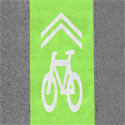 |
Color may be used to supplement shared lane markings for added visibility. Read More+
Salt Lake City, UT, and Long Beach, CA, have used a carpet of green coloring to create a lane-within-a-lane to indicate the priority area and preferred riding placement for bicyclists.
“The green lane facility has appeared to result in an approximate doubling of usage over the first 12 months of existence.”
“Bicyclists familiar with more traditional sharrows have noted that the additional emphasis resulting from the green pavement paint appears to be creating an heightened awareness by the motorists in the lane.”
City of Long Beach. (2010). Final Report: Second Street Sharrows and Green Lane in the City of Long Beach, California (RTE 9-113E).
In an evaluation of a lane-within-a-lane treatment in Salt Lake City, researchers found that “eleven months after implementation, the fraction of in‐street cyclists riding in the preferred zone, at least 4 ft from the curb, had risen from 17% to 92%.”
Furth, P., Dulaski, D. M., Bergenthal, D., Brown, S. (2011). More Than Sharrows: Lane-Within-A-Lane Bicycle Priority Treatments in Three U.S. Cities. Presented at the 2011 Annual Meeting of the Transportation Research Board.
|
Maintenance
- Colored pavement requires varying levels of maintenance depending on materials.
- Because the effectiveness of markings depends entirely on their visibility, maintaining markings should be a high priority.
- Colored facilities should be maintained to be free of potholes, broken glass, and other debris.
Treatment Adoption and Professional Consensus
Application of colored pavement is seen in the following US cities:
- Austin, TX
- Boston, MA
- Cambridge, MA
- Chicago, IL
- Columbia, MO
- Eugene, OR
- Indianapolis, IN
- Minneapolis, MN
- Missoula, MT
- New York, NY
- Portland, OR
- Salt Lake City, UT
- San Francisco, CA
- Seattle, WA
- Washington, DC